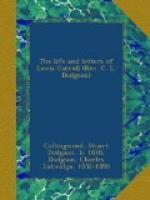A few days after the publication of “Phantasmagoria,” Lewis Carroll sent the first chapter of his new story to the press. “Behind the Looking-Glass and what Alice saw there” was his original idea for its title; it was Dr. Liddon who suggested the name finally adopted.
During this year German and French translations of “Alice in Wonderland” were published by Macmillan; the Italian edition appeared in 1872. Henri Bue, who was responsible for the French version, had no easy task to perform. In many cases the puns proved quite untranslatable; while the poems, being parodies on well-known English pieces, would have been pointless on the other side of the Channel. For instance, the lines beginning, “How doth the little crocodile” are a parody on “How doth the little busy bee,” a song which a French child has, of course, never heard of. In this case Bue gave up the idea of translation altogether, and, instead, parodied La Fontaine’s “Maitre Corbeau” as follows:—
Maitre Corbeau sur un arbre perche
Faisait son nid entre des branches;
Il avait releve ses manches,
Car il etait tres affaire.
Maitre Renard par la passant,
Lui dit: “Descendez donc, compere;
Venez embrasser votre frere!”
Le Corbeau, le reconnaissant,
Lui repondit en son ramage!—
“Fromage.”
The dialogue in which the joke occurs about “tortoise” and “taught us” ("Wonderland,” p. 142) is thus rendered:—
“La maitresse etait une vieille tortue; nous l’appelions chelonee.” “Et pourquoi l’appeliez-vous chelonee, si ce n’etait pas son nom?” “Parcequ’on ne pouvait s’empecher de s’ecrier en la voyant: Quel long nez!” dit la Fausse-Tortue d’un ton fache; “vous etes vraiment bien bornee!”
At two points, however, both M. Bue and Miss Antonie Zimmermann, who translated the tale into German, were fairly beaten: the reason for the whiting being so called, from its doing the boots and shoes, and for no wise fish going anywhere without a porpoise, were given up as untranslatable.
At the beginning of 1870 Lord Salisbury came up to Oxford to be installed as Chancellor of the University. Dr. Liddon introduced Mr. Dodgson to him, and thus began a very pleasant acquaintance. Of course he photographed the Chancellor and his two sons, for he never missed an opportunity of getting distinguished people into his studio.
[Illustration: Lord Salisbury and his two sons. From a photograph by Lewis Carroll.]
In December, seven “Puzzles from Wonderland” appeared in Mrs. Gatty’s paper, Aunt Judy’s Magazine. They had originally been written for the Cecil children, with whom Lewis Carroll was already on the best terms. Meanwhile “Through the Looking-Glass” was steadily progressing—not, however, without many little hitches. One question which exercised Mr. Dodgson very much was whether the picture of the Jabberwock would do as a frontispiece,




